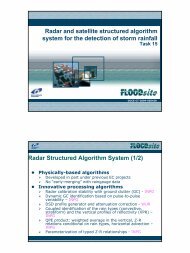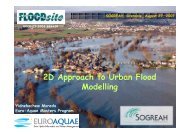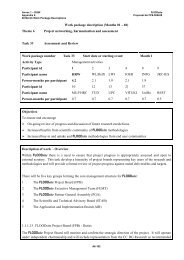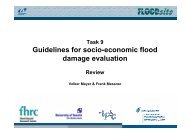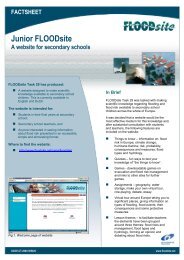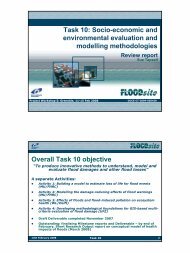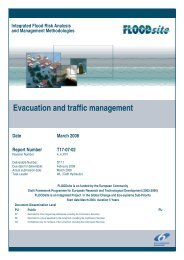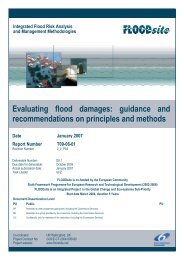Language of Risk - FLOODsite
Language of Risk - FLOODsite
Language of Risk - FLOODsite
You also want an ePaper? Increase the reach of your titles
YUMPU automatically turns print PDFs into web optimized ePapers that Google loves.
<strong>FLOODsite</strong> <strong>Language</strong> <strong>of</strong> <strong>Risk</strong> 2 nd Ed.<br />
Contract No:GOCE-CT-2004-505420<br />
The British government policy – as set out for consultation (Defra, 2004) describes in its vision<br />
“The concept <strong>of</strong> sustainable development will be firmly rooted in all flood risk management and<br />
coastal erosion decisions and operations. Full account will be taken <strong>of</strong> the social, environmental and<br />
economic pillars <strong>of</strong> sustainable development, and our arrangements will be transparent enough to<br />
allow our customers and stakeholders to perceive that this is the case. Account will also continue to be<br />
taken <strong>of</strong> long-term drivers such as climate change. Decisions will reflect the uncertainty surrounding<br />
a number <strong>of</strong> key drivers and will where appropriate take a precautionary approach. Decisions will be<br />
based on the best available evidence and science.”<br />
The Scottish Environment LINK forum (2007) proposed the following definition <strong>of</strong> sustainable flood<br />
management:<br />
Sustainable flood management embodies a shift from our predominantly piecemeal and reactive<br />
approach to flood management towards a catchment-based approach that takes account <strong>of</strong> long-term<br />
social and economic factors and uses natural processes and natural systems to slow down and store<br />
water. Sustainable flood management includes a package <strong>of</strong> measures that together aim to reduce the<br />
risk <strong>of</strong> flooding and minimise the economic, environmental and social costs <strong>of</strong> flooding. This includes<br />
both structural and non-structural measures, such as natural flood management, hard engineering<br />
where necessary, flood risk mapping, flood warning, preparedness, education, and emergency<br />
response.<br />
In the Executive Summary <strong>of</strong> the Royal Society <strong>of</strong> Edinburgh Flooding and Flood Management<br />
Inquiry (2007), the following discussion <strong>of</strong> sustainable flood management is given:<br />
The overall objective is to deliver a resilient response to flooding in which:<br />
• social needs (enhance community benefit, with fair outcomes for everyone),<br />
• environmental needs (protecting and working with the environment, with respect for all species,<br />
habitats, landscapes and built heritage) and<br />
• economic needs (deliver resilience at affordable cost with fair economic outcomes and the<br />
protection <strong>of</strong> local jobs and wealth)<br />
are balanced<br />
The Scottish Executive (2008) consultation on “The Future <strong>of</strong> Flood <strong>Risk</strong> Management in Scotland”<br />
defines sustainable flood management as follows:<br />
“Sustainable flood management provides the maximum possible social and economic resilience*<br />
against flooding**, by protecting and working with the environment, in a way which is fair and<br />
affordable both now and in the future.”<br />
* ‘Resilience’ means: ‘ability to recover quickly and easily’: The Scottish Government uses it to deliver the<br />
‘four As’: Awareness + Avoidance + Alleviation + Assistance.<br />
** Flooding means all types <strong>of</strong> flooding: surface water run-<strong>of</strong>f (pluvial), sewer, river, groundwater, estuarine<br />
and coastal.<br />
In the first edition <strong>of</strong> the <strong>Language</strong> <strong>of</strong> <strong>Risk</strong> a definition based on Samuels (2000) was suggested rather<br />
than one deriving from draft policy discussions in a single EU member state. The IRMA-SPONGE<br />
definition is for a “strategy” rather than the activity or process. The definition was recommended to be<br />
broader than just linking to Integrated Water Resource Management. The word “appropriate” was<br />
been added to the final part <strong>of</strong> the definition to reflect the possibility <strong>of</strong> different criteria being applied<br />
in different countries and at different times. The initial use <strong>of</strong> “Flood defence” has been broadened to<br />
“flood risk management”. This led to the following definition<br />
“Sustainable flood risk management involves:<br />
• ensuring quality <strong>of</strong> life by reducing flood damages but being prepared for floods<br />
• mitigating the impact <strong>of</strong> risk management measures on ecological systems at a variety <strong>of</strong> spatial<br />
and temporal scales<br />
T32_04_01_ <strong>FLOODsite</strong>_<strong>Language</strong>_<strong>of</strong>_<strong>Risk</strong>_D32_2_v5_2_P1 30 April 2009<br />
20



